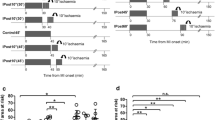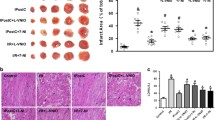Abstract
The isolated perfused heart is an important model in cardiovascular research. We hypothesized that the perfusion procedure per se will phosphorylate some protein kinases important in pre- and postconditioning. Isolated hearts were Langendorff-perfused for 20 min with or without an intraventricular balloon (rats and mice), or in the working heart mode (mice) and compared to non-perfused controls with respect to protein phosphorylation. Rat hearts were also perfused for 20 and 50 min in the Langendorff mode to investigate the effect of perfusion time on phosphorylation. Western blot analysis showed that perfusion per se induced a massive phosphorylation of ERK 1/2, P38-MAPK, JNK, AMPK, but decreased phosphorylation of AKT in the isolated rat and mouse heart. However, during ongoing perfusion the phosphorylation of these kinases was reduced. Langendorff-perfusion without the intraventricular balloon caused less phosphorylation of ERK 1/2, P38-MAPK and JNK, but had no effect on AMPK. In working hearts phosphorylation of kinases was similar to that of Langendorff-perfused hearts without the balloon. Our findings indicate that excising, handling and perfusion induce a time dependent phosphorylation of stress kinases. The presence of the intraventricular balloon caused the strongest phosphorylation, thus Langendorff-perfused hearts might be partly protected by the perfusion procedure if stress kinases are protective in pre- and postconditioning. This might explain conflicting results obtained with different models of both pre- and postconditioning, and the isolated heart might in some situations be suboptimal for such studies.





Similar content being viewed by others
References
Arad M, Seidman CE, Seidman JG (2007) AMP-activated protein kinase in the heart: role during health and disease. Circ Res 100:474–488
Armstrong SC (2004) Protein kinase activation and myocardial ischemia/reperfusion injury. Cardiovasc Res 61:427–436
Baba HA, Stypmann J, Grabellus F, Kirchhof P, Sokoll A, Schafers M, Takeda A, Wilhelm MJ, Scheld HH, Takeda N, Breithardt G, Levkau B (2003) Dynamic regulation of MEK/Erks and Akt/GSK-3 beta in human end-stage heart failure after left ventricular mechanical support: myocardial mechanotransduction-sensitivity as a possible molecular mechanism. Cardiovasc Res 59:390–399
Baines CP, Molkentin JD (2005) STRESS signaling pathways that modulate cardiac myocyte apoptosis. J Mol Cell Cardiol 38:47–62
Behrends M, Schulz R, Post H, Alexandrov A, Belosjorow S, Michel MC, Heusch G (2000) Inconsistent relation of MAPK activation to infarct size reduction by ischemic preconditioning in pigs. Am J Physiol Heart Circ Physiol 279:H1111–H1119
Bell JR, Eaton P, Shattock MJ (2008) Role of p38-mitogen-activated protein kinase in ischaemic preconditioning in rat heart. Clin Exp Pharmacol Physiol 35:126–134
Bopassa JC, Ferrera R, Gateau-Roesch O, Couture-Lepetit E, Ovize M (2006) PI3-kinase regulates the mitochondrial transition pore in controlled reperfusion and postconditioning. Cardiovasc Res 69:178–185
Chen AH, Gortler DS, Kilaru S, Araim O, Frangos SG, Sumpio BE (2001) Cyclic strain activates the pro-survival Akt protein kinase in bovine aortic smooth muscle cells. Surgery 130:378–381
Clerk A, Fuller SJ, Michael A, Sugden PH (1998) Stimulation of “stress-regulated” mitogen-activated protein kinases (stress-activated protein kinases/c-Jun N-terminal kinases and p38-mitogen-activated protein kinases) in perfused rat hearts by oxidative and other stresses. J Biol Chem 273:7228–7234
Currie RW, Karmazyn M, Kloc M, Mailer K (1988) Heat-shock response is associated with enhanced postischemic ventricular recovery. Circ Res 63:543–549
da Silva R, Grampp T, Pasch T, Schaub MC, Zaugg M (2004) Differential activation of mitogen-activated protein kinases in ischemic and anesthetic preconditioning. Anesthesiology 100: 59–69
de Jonge HW, Dekkers DHW, Houtsmuller AB, Sharma HS, Lamers JMJ (2007) Differential signaling and hypertrophic responses in cyclically stretched vs endothelin-1 stimulated neonatal rat cardiomyocytes. In: 2nd international conference on recent advances in biomedical and therapeutic sciences (ICRABTS). Jhansi, India, pp 21–32
De Windt LJ, Willems J, Reneman RS, Van der Vusse GJ, Arts T, Van Bilsen M (1999) An improved isolated, left ventricular ejecting, murine heart model—functional and metabolic evaluation. Pflugers Arch 437:182–190
Dyck JRB, Lopaschuk GD (2006) AMPK alterations in cardiac physiology and pathology: enemy or ally? J Physiol 574:95–112
Hardie DG (2004) AMP-activated protein kinase: the guardian of cardiac energy status. Clin Invest 114:465–468
Hausenloy DJ, Tsang A, Mocanu MM, Yellon DM (2005) Ischemic preconditioning protects by activating prosurvival kinases at reperfusion. Am J Physiol 288:H971–H976
Hausenloy DJ, Yellon DM (2004) New directions for protecting the heart against ischaemia-reperfusion injury: targeting the reperfusion injury salvage kinase (RISK)-pathway. Cardiovasc Res 61:448–460
Hausenloy DJ, Yellon DM (2006) Survival kinases in ischemic preconditioning and postconditioning. Cardiovasc Res 70:240–253
Headrick JP, Peart J, Hack B, Flood A, Matherne GP (2001) Functional properties and responses to ischaemia-reperfusion in Langendorff perfused mouse heart. Exp Physiol 86:703–716
Heusch G, Boengler K, Schulz R (2008) Cardioprotection: nitric oxide, protein kinases, and mitochondria. Circulation 118:1915–1919
Hsieh MH, Nguyen HT (2005) Molecular mechanism of apoptosis induced by mechanical forces. In: International review of cytology—a survey of cell biology, vol 245. Elsvier, San Diego, USA pp 45–90Please provide the publisher location for the reference Hsieh and Nguyen (2005)
Huang CH, Wang JS, Chiang SC, Wang YY, Lai ST, Weng ZC (2004) Brief pressure overload of the left ventricle preconditions rabbit myocardium against infarction. Ann Thorac Surg 78:628–633
Kakisis JD, Liapis CD, Sumpio BE (2004) Effects of cyclic strain on vascular cells. Endothelium 11:17–28
Kaljusto ML, Mori T, Mohammad Husain Rizvi S, Galagudza M, Frantzen ML, Valen G, Vaage J (2006) Postconditioning in rats and mice. Scand Cardiovasc J 40:334–341
Kaljusto ML, Stenslokken KO, Mori T, Panchenko A, Frantzen ML, Valen G, Vaage J (2008) Preconditioning effects of steroids and hyperoxia on cardiac ischemia-reperfusion injury and vascular reactivity. Eur J Cardiothorac Surg 33:355–363
Komuro I, Kudo S, Yamazaki T, Zou YZ, Shiojima I, Yazaki Y (1996) Mechanical stretch activates the stress-activated protein kinases in cardiac myocytes. Faseb J 10:631–636
Kumar P, Peers C (2006) AMP-activated protein kinase: function and dysfunction in health and disease. J Physiol Lond 574:3–6
Li YSJ, Haga JH, Chien S (2005) Molecular basis of the effects of shear stress on vascular endothelial cells. J Biomech 38:1949–1971
Nishino Y, Miura T, Miki T, Sakamoto J, Nakamura Y, Ikeda Y, Kobayashi H, Shimamoto K (2004) Ischemic preconditioning activates AMPK in a PKC-dependent manner and induces GLUT4 up-regulation in the late phase of cardioprotection. Cardiovasc Res 61:610–619
Schulz R, Belosjorow S, Gres P, Jansen J, Michel MC, Heusch G (2002) p38 MAP kinase is a mediator of ischemic preconditioning in pigs. Cardiovasc Res 55:690–700
Seko Y, Seko Y, Takahashi N, Tobe K, Kadowaki T, Yazaki Y (1999) Pulsatile stretch activates mitogen-activated protein kinase (MAPK) family members and focal adhesion kinase (p125(FAK)) in cultured rat cardiac myocytes. Biochem Biophys Res Commun 259:8–14
Siddall HK, Warrell CE, Yellon DM, Mocanu MM (2008) Ischemia-reperfusion injury and cardioprotection: investigating PTEN, the phosphatase that negatively regulates PI3K, using a congenital model of PTEN haploinsufficiency. Basic Res Cardiol 103:560–568
Sivaraman V, Mudalagiri NR, Di Salvo C, Kolvekar S, Hayward M, Yap J, Keogh B, Hausenloy DJ, Yellon DM (2007) Postconditioning protects human atrial muscle through the activation of the RISK pathway. Basic Res Cardiol 102:453–459
Skyschally A, van Caster P, Boengler K, Gres P, Musiolik J, Schilawa D, Schulz R, Heusch G (2009) Ischemic postconditioning in pigs no causal role for risk activation. Circ Res 104:15–18Please provide the volume and page range for the reference Skyschally et al. (2008)
Sukhodub A, Jovanovic S, Du QY, Budas G, Clelland AK, Shen M, Sakamoto K, Tian R, Jovanovic A (2007) AMP-activated protein kinase mediates preconditioning in cardiomyocytes by regulating activity and trafficking of sarcolemmal ATP-sensitive K+ channels. J Cell Physiol 210:224–236
Sutherland FJ, Hearse DJ (2000) The isolated blood and perfusion fluid perfused heart. Pharmacol Res 41:613–627
Tahepold P, Valen G, Starkopf J, Kairane C, Zilmer M, Vaage J (2001) Pretreating rats with hyperoxia attenuates ischemia-reperfusion injury of the heart. Life Sci 68:1629–1640
Takeshima S, Vaage J, Valen G (1997) Preconditioning the globally ischaemic, isolated rat heart: the impact of the preconditioning model on post-ischaemic systolic and diastolic function. Scand J Clin Lab Invest 57:637–646
Tsang A, Hausenloy DJ, Mocanu MM, Carr RD, Yellon DM (2005) Preconditioning the diabetic heart: the importance of Akt phosphorylation. Diabetes 54:2360–2364
Tsang A, Hausenloy DJ, Mocanu MM, Yellon DM (2004) Postconditioning: a form of “modified reperfusion” protects the myocardium by activating the phosphatidylinositol 3-kinase-Akt pathway. Circ Res 95:230–232
Zaugg M, Lucchinetti E, Uecker M, Pasch T, Schaub MC (2003) Anaesthetics and cardiac preconditioning. Part I: signalling and cytoprotective mechanisms. Br J Anaesth 91:551–565
Acknowledgments
The technical assistance by May Britt Dahl is gratefully acknowledged. Disclosures: None. Sources of funding: This study has been supported by the University of Oslo (JV), Ullevål University. Hospital (KOS and JV), Eastern Norway Regional Health Authority (JV) and Norwegian National Health Association (JV).
Author information
Authors and Affiliations
Corresponding author
Additional information
Returned for 1. Revision: 4 September 2008 1. Revision received: 20 October 2008
Returned for 2. Revision: 31 October 2008 2. Revision received: 5 December 2008
Returned for 3. Revision: 15 December 2008 3. Revision received: 6 January 2009
Electronic supplementary material
Below is the link to the electronic supplementary material.
Rights and permissions
About this article
Cite this article
Stensløkken, KO., Rutkovskiy, A., Kaljusto, ML. et al. Inadvertent phosphorylation of survival kinases in isolated perfused hearts: a word of caution. Basic Res Cardiol 104, 412–423 (2009). https://doi.org/10.1007/s00395-009-0780-1
Received:
Accepted:
Published:
Issue Date:
DOI: https://doi.org/10.1007/s00395-009-0780-1




